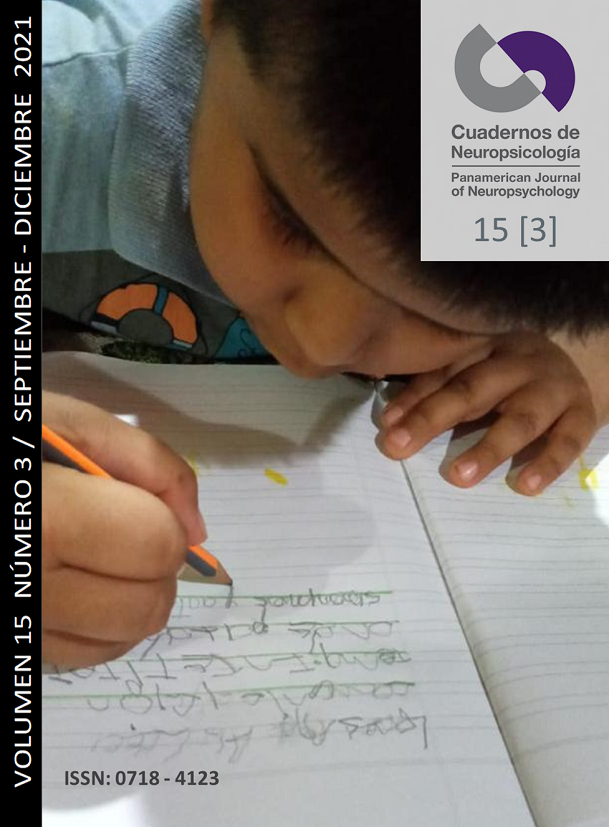Revisión teórica de múltiples temas sobre Estimulación Cerebral Profunda en la enfermedad de Parkinson: conceptos básicos que enfatizan las contribuciones neuropsicológicas
Abstract
Abstract
Parkinson’s disease (PD) is a chronic-degenerative condition associated with the loss of dopaminergic innervation in the striatum. The functional neurosurgical intervention in PD aims, primarily, to restore neurological functions, promoting quality of life. Deep Brain Stimulation (DBS) therapy, in essence, consists of implanting electrodes in specific and predetermined brain targets, mainly in the Subthalamic Nucleus (STN) and the Globus Pallidus interna (GPi). Using a telemetric device with a specific software program, it is possible to select which zones of contact will be active, in addition to the configuration of a variety of electrical parameters, so as to minimize motor and non-motor symptoms. Neuropsychological aspects and a list of basic concepts such as election criteria for DBS; possible surgical complications; device settings; multidisciplinarity; combined therapies; ethical aspects, and future challenges will be succinctly addressed in this theoretical rapid-review article.
Key words: Parkinson’s disease; Deep Brain Stimulation; Neuropsychology; Multidisciplinarity; Ethics.
Â
Resumen
La enfermedad de Parkinson (EP) es una afección crónico-degenerativa asociada con la pérdida de inervación dopaminérgica en el cuerpo estriado. La intervención neuroquirúrgica funcional en la EP tiene como objetivo, principalmente, restaurar las funciones neurológicas y promover la calidad de vida. La terapia de Estimulación Cerebral Profunda (ECP) consiste fundamentalmente en la implantación de electrodos en dianas cerebrales especÃficas y predeterminadas, especialmente en el Núcleo Subtalámico (STN) y en el Globo Pálido interno (GPi). Usando un dispositivo telemétrico con un programa de software especÃfico es posible seleccionar qué zonas de contacto estarán activas además de la configuración de una variedad de parámetros eléctricos, con el fin de minimizar los sÃntomas motores y no motores. Además los aspectos neuropsicológicos, una lista de conceptos básicos como criterios de elección para ECP; posibles complicaciones quirúrgicas; configuración del dispositivo; multidisciplinariedad; terapias combinadas; aspectos éticos y desafÃos futuros se abordarán de manera sucinta en este breve artÃculo teórico de revisión.
Palabras Clave: Enfermedad de Parkinson; Estimulación Cerebral Profunda; neuropsicologÃa; Multidisciplinariedad; Ética.
Â
Resumo
A doença de Parkinson (DP) é uma condição crônico-degenerativa associada à perda da inervação dopaminérgica no corpo estriado. A intervenção neurocirúrgica funcional na DP objetiva, principalmente, restaurar as funções neurológicas e promover qualidade de vida. A terapia de Estimulação Cerebral Profunda (ECP) consiste, fundamentalmente, no implante de eletrodos em alvos cerebrais especÃficos e pré-determinados, especialmente no Núcleo Subtalâmico (STN) e no Globo Pálido interno (GPi). Utilizando um dispositivo telemétrico com programa de software especÃfico é possÃvel selecionar quais zonas de contato estarão ativas, além da configuração de diversos parâmetros elétricos, de forma a minimizar sintomas motores e não motores. Aspectos neuropsicológicos e uma lista de conceitos básicos como critérios eletivos para ECP; possÃveis complicações cirúrgicas; configurações do dispositivo; multidisciplinaridade; terapias combinadas; aspectos éticos e desafios futuros serão abordados de forma sucinta neste breve artigo teórico de revisão.
Palavras-chave: Doença de Parkinson; Estimulação Cerebral Profunda; Neuropsicologia; Multidisciplinaridade; ÉticaDownloads
How to Cite
Issue
Section
License
Articles published in this journal are protected under the Creative Commons Attribution-NonCommercial-ShareAlike 4.0 International (CC BY-NC-SA 4.0) license. This means that authors retain full rights over their research and publications at all times. As a journal, we fully respect and promote the principles of open access established by this license, allowing the work to be shared, adapted, and distributed for non-commercial purposes, provided that appropriate credit is given to the authors and any derivative works are licensed under the same terms.
Authors are responsible for obtaining the required permission when they wish to reproduce part of the material (figures, etc.) from other publications.
Likewise, CNPs allows authors to host in their personal sites or other repositories that they deem convenient the Final and Definitive Version of the published article with the format assigned by the journal. In no case do we allow access to preprints of the article under evaluation or already published.
When submitting an article to CNPs you are aware that all the contents of CNPs are under a Creative Commons License. In which it is allowed to copy and share the contents freely, always making reference to the origin of the publication and its author.





